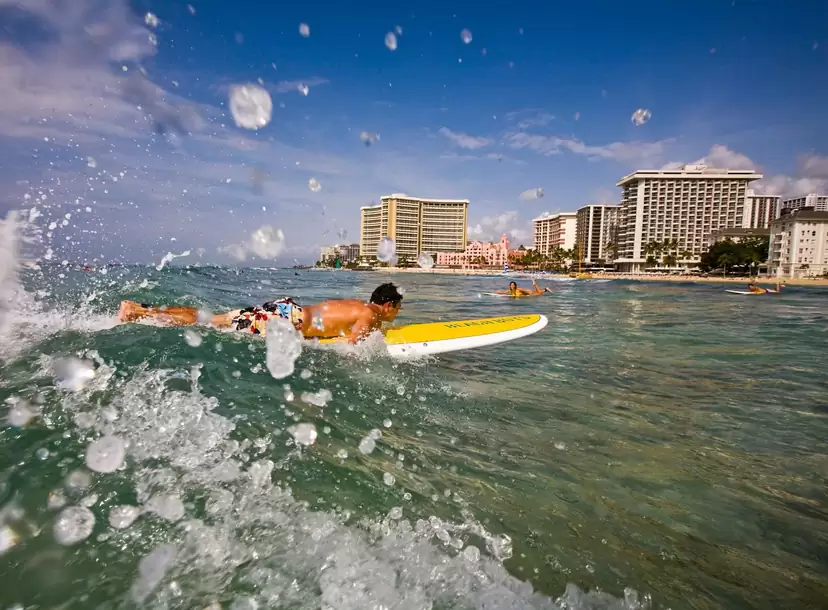Hawaii, known for its stunning beaches, lush landscapes, and vibrant culture, holds a special place in the hearts of surfers worldwide. Among its many treasures, the surf breaks of Hawaii stand out as legendary, drawing enthusiasts from around the globe. This article delves into the world of Hawaiian surf breaks, exploring their history, unique characteristics, and the reasons why they have achieved legendary status.
Introduction
Hawaii’s surf breaks are more than just spots to catch waves; they are hallowed grounds for surfers. From the beginner-friendly waves of Waikiki to the formidable barrels of Pipeline, Hawaii offers a diverse range of surfing experiences. This guide aims to provide a detailed look into these legendary surf breaks, offering insights and practical information for surfers of all levels.
The History of Surfing in Hawaii
Origins and Cultural Significance
Surfing, or he’e nalu in Hawaiian, has deep roots in Hawaiian culture. Ancient Hawaiians viewed surfing as an art form, a sport, and a spiritual experience. It was often associated with royalty, known as the sport of kings. Ali’i (chiefs) were known to demonstrate their prowess and social status through their surfing skills. The waves were considered a gift from the gods, and surfers would pray and offer gifts to the sea before venturing out.
Evolution of Surfing
The modern history of surfing in Hawaii began in the early 20th century, when tourism started to bring international attention to the islands. Duke Kahanamoku, a Hawaiian native and Olympic swimmer, is credited with popularizing surfing worldwide. His demonstrations and infectious enthusiasm for the sport helped to spread the culture of surfing far beyond Hawaii’s shores.
Iconic Surf Breaks in Hawaii
Hawaii boasts numerous surf breaks, each with its unique features and challenges. Here are some of the most iconic ones:
Waikiki Beach
Overview
Waikiki Beach, located on the south shore of Oahu, is one of the most famous and accessible surf spots in Hawaii. Known for its gentle, rolling waves, Waikiki is an ideal spot for beginners and longboarders. The beach is lined with resorts, making it a popular destination for tourists.
Wave Characteristics
The waves at Waikiki break over a sandy bottom, providing a forgiving environment for new surfers. The swells are consistent year-round, with wave heights typically ranging from 2 to 4 feet, though they can occasionally reach 6 feet during the summer.
Pipeline
Overview
Banzai Pipeline, often simply called Pipeline, is located on the North Shore of Oahu. It is renowned for its powerful, hollow waves that break over a shallow reef, creating some of the most challenging and dangerous conditions in the world. You can also read How to Determine if Bisco Is Dead: A Comprehensive Guide
Wave Characteristics
Pipeline is famous for its perfect barrels, which attract professional surfers from around the globe. The waves can reach heights of up to 20 feet during the winter months, making it a prime location for big-wave surfing competitions.
Waimea Bay
Overview
Waimea Bay, also on the North Shore of Oahu, is a legendary big-wave surf spot. It gained fame in the 1950s and 60s as the premier location for big-wave surfing, a status it still holds today.
Wave Characteristics
The waves at Waimea Bay can reach towering heights of up to 30 feet during the winter swell season. The break requires precise timing and expert skill to navigate, making it a spot reserved for the most experienced surfers.
Sunset Beach
Overview
Sunset Beach, another North Shore gem, is known for its long, powerful waves that provide a variety of surfing experiences. It is a staple on the professional surfing tour circuit.
Wave Characteristics
The waves at Sunset Beach can vary greatly, ranging from small, fun waves suitable for intermediate surfers to massive, challenging waves during the peak winter season. The break can handle a variety of swell directions, making it a versatile spot for surfers.
The Unique Characteristics of Hawaiian Surf Breaks
Wave Formation and Quality
Hawaiian surf breaks are known for their high-quality waves, which result from the unique geography of the islands and the surrounding ocean currents. The underwater topography, including reefs and volcanic rock formations, plays a crucial role in shaping the waves.
Seasonal Variations
Hawaii’s surf seasons are divided into winter and summer. The North Shore of Oahu experiences massive swells during the winter months (November to February), attracting big-wave surfers. In contrast, the south shores see smaller, more manageable waves during the summer (June to August), ideal for beginners and longboarders.
Local Surf Culture
Surfing in Hawaii is deeply embedded in local culture. Respect for the ocean, the environment, and fellow surfers is paramount. The concept of “aloha” extends to the surf community, emphasizing kindness, respect, and humility.
The Influence of Hawaiian Surfing on Global Surf Culture
Hawaii’s surf culture has had a profound impact on the global surfing community. The innovations in board design, surfing techniques, and the establishment of professional competitions all trace their roots back to the Hawaiian Islands. The spirit of aloha and the respect for the ocean have also influenced the ethos of surfers worldwide.
Planning Your Surf Trip to Hawaii
Best Times to Visit
The best time to surf in Hawaii depends on your skill level and the type of waves you seek. Winter is ideal for experienced surfers looking for big waves on the North Shore, while summer offers smaller, more manageable waves on the south shores for beginners.
Essential Gear
When planning a surf trip to Hawaii, it’s important to bring the right gear. A good wetsuit is essential during the winter months, especially on the North Shore. A variety of surfboards may be needed, from longboards for gentle waves to shortboards for more aggressive surf. Don’t forget reef-safe sunscreen to protect both your skin and the environment.
Safety Tips
Surfing in Hawaii can be hazardous, especially at the more challenging breaks. Always check the surf conditions and weather forecasts before heading out. Respect the local surfers and follow the rules of the lineup. It’s also crucial to be aware of the reef and other underwater hazards.
Conclusion
Hawaii’s legendary surf breaks offer an unparalleled surfing experience, steeped in rich history and cultural significance. Whether you’re a seasoned pro seeking the thrill of massive waves or a beginner looking to catch your first ride, Hawaii has something for everyone. By understanding the unique characteristics of each break and respecting the local culture, you can enjoy the waves and make the most of your Hawaiian surf adventure.
From the gentle swells of Waikiki to the powerful barrels of Pipeline, the legendary surf breaks of Hawaii continue to captivate and challenge surfers from around the world. Their influence on global surf culture is undeniable, and their allure remains as strong as ever. So pack your bags, grab your board, and head to Hawaii to experience the magic of its legendary surf breaks.




